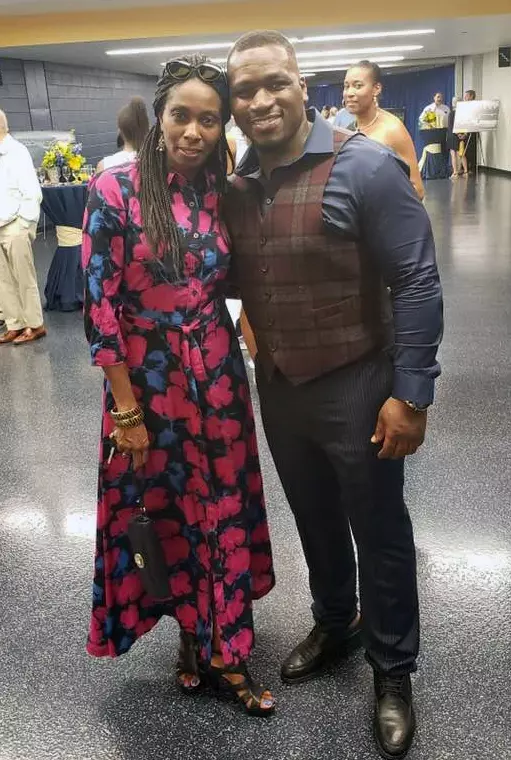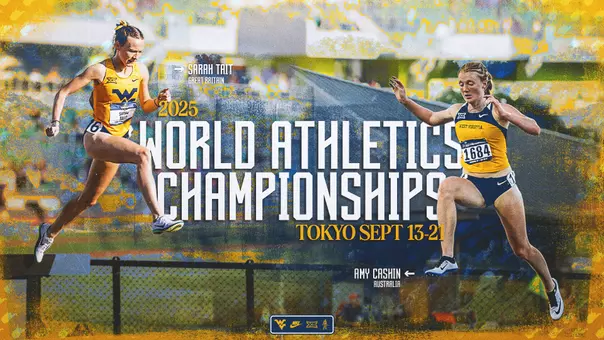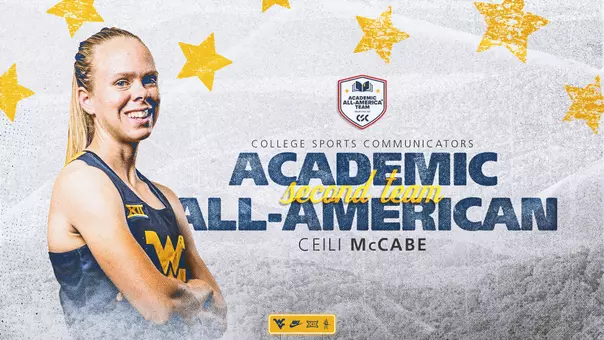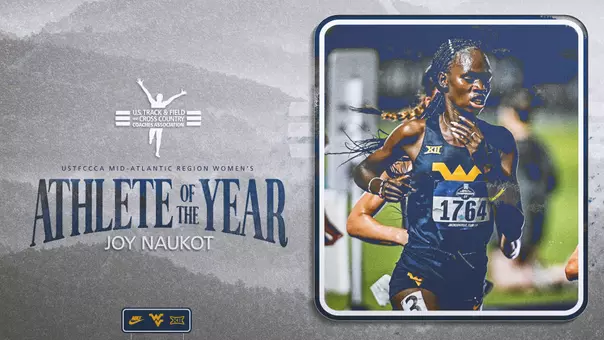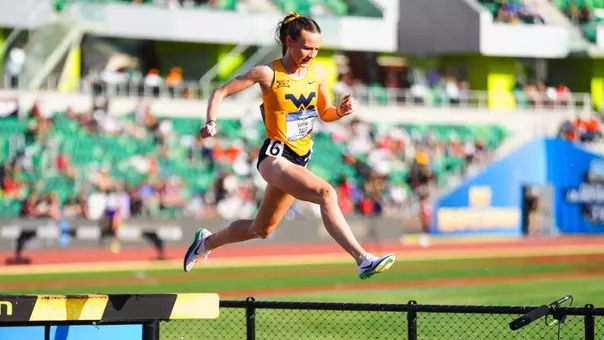WVU’s Itanyi First Female Track and Field National Champion
February 25, 2022 09:00 AM | Track & Field, Blog
This is the final installment in our series of Black History Month features running Fridays on WVUsports.com.
MORGANTOWN, W.Va. – Patience “Pat” Itanyi’s journey to track and field stardom at West Virginia University took more twists and turns than one of those two-lane country roads that we've become so familiar with around here.
She grew up in the village of Ukehe in Nigeria, about an hour and a half drive south to the closest major city, Enugu, with a population of about 800,000. It’s about a 9 ½-hour drive west to Lagos, situated on the Gulf of Guinea.

Pat was discovered while competing in a youth competition in Ghana - not by WVU, but rather by someone tied to Alabama A&M’s track and field coach, who had built a Division II powerhouse there with a roster full of Nigerians. Pat figured going to the United States was a good way to help her qualify for the 1996 Olympics and get a college education in the process – both things that were financially unattainable at the time.
What she didn’t understand then was the NCAA classification system.
“Once I got there, I realized I was in the wrong classification because I didn’t know anything about D-I, D-II or D-III,” she recalled recently. “I wanted to compete at the highest level to help me qualify for the Olympics.”
Itanyi’s one season at Alabama A&M in 1994 saw her earn Division II All-America honors in the hurdles and the heptathlon. That led to her receiving a bunch of interest from Division I schools when she made it known that she wanted to transfer up to the highest level.
Understandably, her coach wasn’t too thrilled about the idea of losing her after all of the time and effort he had invested, so when other schools inquired about her availability, he simply ignored them. When Pat became aware that her coach was trying to hide her, she wanted out immediately. With the help of her aunt and confidant, Esther Ikomi, they went to the athletic director’s office and demanded the school release her.
“At that point I was like, ‘I don’t care where I go, I just want to leave.’ I was so upset that all of these things were happening without me know about them,” she said.
Interested schools such as Clemson, UCLA and North Carolina had already given up on her with the fall semester underway. But West Virginia was one of the schools willing to stick it out. She didn’t really know much about West Virginia other than it had a Nigerian runner, Kay Iheagwan, whom she once saw running at a meet in Knoxville, Tennessee, for the Mountaineers.
Otherwise, West Virginia didn’t really stick out much from the hundreds of other college programs around the country. She did become more interested in WVU when coaches Marty Pushkin and Jeff Huntoon said they would get her help getting caught up on her schoolwork if she came to Morgantown.
“So that’s how I ended up at West Virginia,” she said.
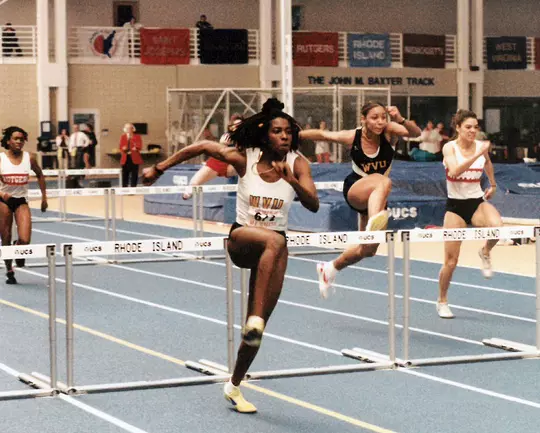
What West Virginia was getting was one of the world’s most gifted athletes at the time. Women’s track started here in 1978 and it took about eight years before the Mountaineers had an athlete good enough to qualify for NCAA nationals - New Castle, Pennsylvania, sprinter Tammy Henderson.
Wilmington, Delaware, hurdler Connie Ellerbe was really the first major talent to compete for West Virginia women's track in the late 1980s, however. She earned All-America honors under coach Laura Nardelli, but really blossomed when the women’s program merged with Pushkin’s men’s program in 1992.
Ellerbe finished second in the 400-meter hurdles at outdoor nationals in Austin, Texas, that year and nearly qualified for the U.S. Olympic team later that summer when she placed fifth at the U.S. Olympic Trials. WVU also had an All-American high jumper at the time in Fairmont native Alethea Moody, who placed sixth at outdoor nationals in 1990. Those two, along with sprinter Trinese Summerlin, were the school’s three All-American performers when Itanyi transferred to WVU in 1994.
At the time, West Virginia was considered a solid track and field program – perhaps even a superpower within the Atlantic 10 Conference budget-wise - but it was not on par with Texas, LSU and the other southern programs with enough roster depth to win national titles.
And once Pat got to WVU and she saw the outdoor track and the well-worn indoor facility, it didn’t really deter her much because she knew that she was going to be at the biggest meets and performing against some of the best athletes in the world anyway.
“I was raised that any situation you find yourself in to make the best out of it,” she explained.
Immediately, West Virginia saw the value of her versatility. She basically won the Atlantic 10 indoor title for the Mountaineers by herself, placing first in the 55-meter hurdles and the long jump, and competing on several different relays.
Any event she could run that day she did.
“At the end of that meet I was dead. That’s the meet when they really got their scholarship money out of me,” she laughed.
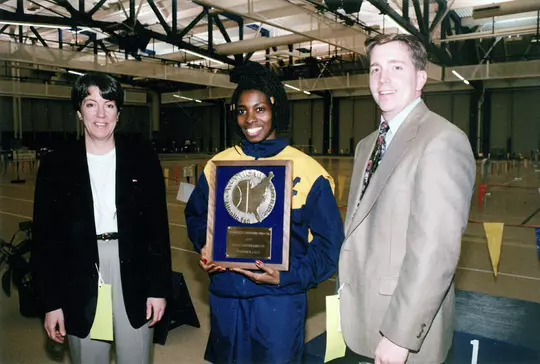
Itanyi admits West Virginia worked her harder than she had ever worked before, and it paid off handsomely in Knoxville at the end of the year when she qualified for nationals in the long jump and the 100-meter hurdles. Itanyi stunned the entire field by winning the women’s long jump national title with an incredible leap of 22 feet, 1 inch.
Twenty-two feet in women’s long jump is sort of considered like the four-minute barrier once was to men’s milers back in the 1950s. The first two females to jump 22 feet at the NCAA championships were Hawaii’s Gwen Loud and Nebraska’s Angie Tacker in 1984.
Carol Lewis, the sister of Carl Lewis, did it in 1985. LSU’s Sheila Echols did it in 1987, Cal’s Sheila Hudson in 1990, LSU’s Daphnie Saunders in 1993, Tennessee’s Dedra Davis, North Carolina’s Marion Jones and George Mason’s Diane Guthrie in 1994 did it too.
That’s it.
Then Itanyi popped her jump in 1995, beating Guthrie and Jones in the process. The next athlete to surpass 22 feet at NCAA nationals was Auburn’s Elva Goulbourne in 2002 – seven years later!
It’s only happened about 25 times in the history of the meet, so that should give you an idea what Itanyi accomplished that June afternoon in Knoxville.
But then again, it really doesn’t.
Current West Virginia coach Sean Clearly, a graduate assistant for the Mountaineers then, recalled the 100-meter hurdle race Pat ran that weekend, as well. She had a full-hurdle lead on the rest of the field in the semifinals when she clipped a hurdle late in the race and ended up not reaching the finals. Cleary believes she was headed for a time in the 12.7 to 12.8 range, which easily would have been fast enough to win the national championship that year.
Three-time NCAA champion Gillian Russell won the 100-meter hurdles in 1995 with a time of 12.99.
Of course, this is purely speculative, but had Pat won NCAA championships in two different events then you’re talking about Jackie Joyner-Kersee/Gail Devers-level stuff. Pat recalled turning down an offer to sign a lucrative professional contract soon after winning the NCAA long jump title.
“There was a manager that wanted me to sign with Nike, but I would have to leave school,” she said. “My aunt said, ‘No you are not doing that. You are finishing school first!’”
And she did.
Pat went on to have a tremendous collegiate career at WVU, earning a total of seven All-America honors during her three seasons competing for the Mountaineers from 1995-97.
She was the first female track and field national champion in school history and remains one of only three ever – miler Kate Vermeulen (1999) and 5,000-meter standout Megan Metcalfe (2005) being the other two. The men’s program has only one national champion and his name is not James Jett, it’s Mike Mosser, and he did it in 1972.
Pat never reached 22 feet again, hitting 21 feet, 1 inch at outdoor nationals during her senior year in 1997 to place third. A hamstring injury prohibited her from competing in the 1996 Summer Olympics in Atlanta, but she did represent Nigeria in the 2000 Games in Sydney, Australia, when she was competing for the Sporting Club in Lisbon, Portugal.
She was also the first Mountaineer female to ever compete in the Olympics in track and field.
“Pat made the Olympics 100% natural,” Cleary notes, "and she did it cleanly.”
Itanyi came back to WVU and worked on the Mountaineer coaching staff until 2005 and also returned to the Olympics in 2008 as an assistant coach for Nigeria. She currently lives in Philadelphia with her husband, Anthony Williams, Villanova’s associate head track and field coach. They have one daughter, Tonya, now a freshman in high school. In her spare time, Pat coaches The Agnes Irwin School girls track team.
She was inducted into the West Virginia University Sports Hall of Fame in 2011 and was named a Mountaineer Legend in 2018.
During her time at WVU she earned two degrees, including a master’s degree in athletic coaching in 2003, so her goal of coming to the United States to get a college degree and compete in the Olympics was fulfilled.
“West Virginia will always be home to me,” she said.
Itanyi admits she didn’t fully appreciate at the time what it meant to be a collegiate national champion. She did recall getting a bouquet of flowers from the athletic department delivered to her hotel room the morning after she won the national championship, which she thought was very nice. That probably made more of an impression on her than standing at the top of the podium - above Guthrie, LSU’s Marita Hunt and the since-disgraced Jones.
That’s the air West Virginia University’s Pat Itanyi was breathing back then!
“Pat is one of the greatest athletes this university has ever produced,” Cleary noted.
As for her 22 feet, 1 inch jump, around here that’s similar to Joe DiMaggio’s 56-game hitting streak or Wilt Chamberlain’s 100 points scored in a single game – a school record that most likely will never be broken.
